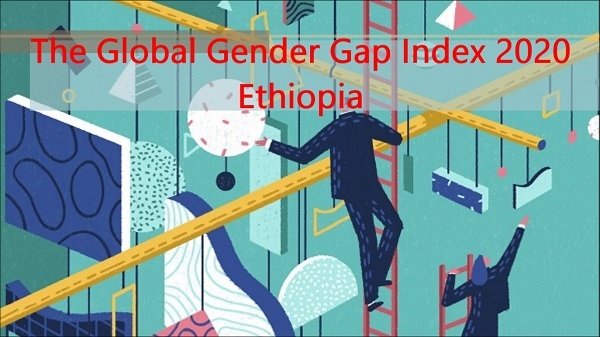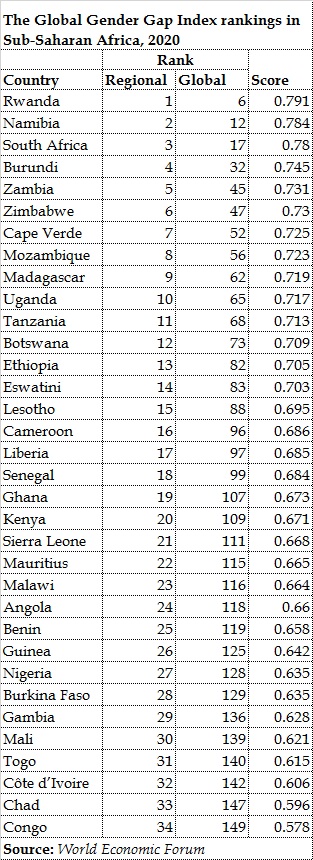
Where Ethiopia stands on the Global Gender Gap Index 2020 – Despite certain improvements, Ethiopia has a lot to work on gender parity
(World Economic Forum) – None of us will see gender parity in our lifetimes, and nor likely will many of our children. That’s the sobering finding of the Global Gender Gap Report 2020, which reveals that gender parity will not be attained for 99.5 years. Here we present the report’s part specific to Ethiopia, while the full report can be found elsewhere.
Ethiopia is 82nd in the 2020 rankings and has closed 70.5% of its gender gap to date. It has achieved full parity on its Health and Survival subindex and has attained the 16th position globally in terms of Political Empowerment. Almost half (47.6%) of ministers are women, and a woman was elected president in 2018. In addition, 38.8% of parliament seats are occupied by women.
Despite these remarkable results, women still suffer from underdevelopment in health services. For instance, every year 400 mothers out of every 100,000 die giving birth, and only 27% of births are attended by skilled health personnel. Further, Ethiopia is struggling to progress on gender parity in education (85.0%, 140th) and economic opportunities (56.8%, 125th).
Investments in human capital are insufficient in general, but women are even more penalized than men. Only 44% of women and 59% of men are literate, and almost 20% of girls and 12% of boys are not receiving formal primary education. At higher levels of education, participation is even lower: only 5.2% of women and 10.9% of men graduating from high school attend university.
In Ethiopia, delays in preparing the talent pool also translate into low employment performances. Labor force participation is skewed towards men: 87.8% of men are in active employment versus 77% of women. Wages and income are low in general, and gender gaps are still significant (51% and 42% of the wage and income gender gaps are yet to be closed).
Women in Ethiopia are also a minority among skilled workers (32.6%) and managers and senior officials (26.5%). Despite the fact that legislation does not restrain women from accessing assets, there are still some limitations for women who belong to some ethnic or social groups, which leads to a relatively low number of female entrepreneurs (16.5%) in general.
Where Ethiopia stands on the Global Gender Gap Index 2020
The top five most-improved countries in the overall index this year (Ethiopia, Spain, Mali, Albania, and Mexico) have all closed their gaps by 3.4 percentage points or more, and they all share a substantial increase in women’s presence in political institutions.
- Ethiopia’s 2019 Score 0.705 (Rank: 82)
Rank change (from 2018): 35
Score change (from 2018): +0.049
Score change (from 2006): +0.111 - Where Ethiopian stands on the Global Gender Gap Index rankings by subindex, 2020
- Economic Participation and Opportunity
Ranked 125 with score 0.568 - Educational Attainment
Ranked 140 with score 0.850 - Health and Survival
Ranked 63 with score 0.976 - Political Empowerment
Ranked 16 with score 0.427
- Economic Participation and Opportunity
Where Ethiopia stands on the Global Gender Gap Index rankings by region, 2020 (Sub-Saharan Africa)
Sub-Saharan Africa has closed 68.0% of its gender gap so far. Seven of the 33 have narrowed their gender gap by more than 2 percentage points; the most improved country (Ethiopia) has reduced almost 5 percentage points of its gap in one year and has currently closed 70.5% of its overall gender gap.
Notably, seven countries (Madagascar, Ghana, Mozambique, Burkina Faso, Ethiopia, Liberia and Mali) have reduced their Educational Attainment gap between 1.5 and 4.7 percentage points.
Gender differences in education remain particularly large beyond elementary school. For instance, gender gaps in tertiary enrolment are as large as 81% in Chad, and over 50% in Ethiopia, Burundi, Benin, Guinea, Mali and Sierra Leone.
Income and wage gender gaps are also large in most Sub-Saharan countries. In terms of wages, few countries (Burundi, Rwanda and Guinea and Gambia) have already closed at least 75% of their gaps, while Ethiopia and Lesotho have yet to close over 50% of their gaps. Women in ministerial positions are between 18% and 8% across 15 economies. Rwanda, South Africa and Ethiopia are important positive exceptions, with more than 48% of women among their ministers. The presence of women is even scarcer at the head-of state level; 24 countries of the 34 assessed have never had a woman as a head of state over the past 50 years.

Source: World Economic Forum
